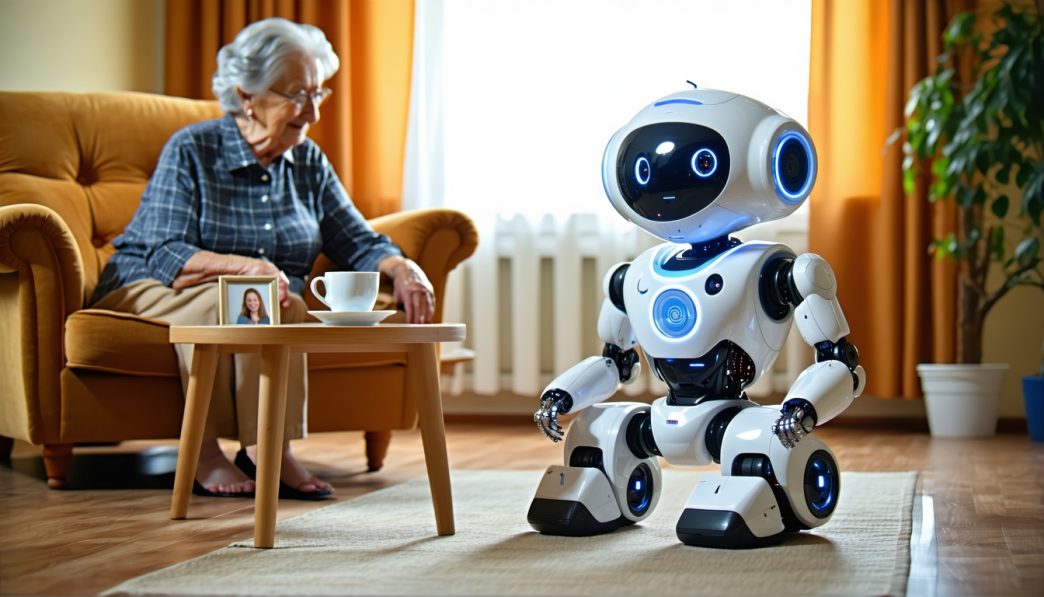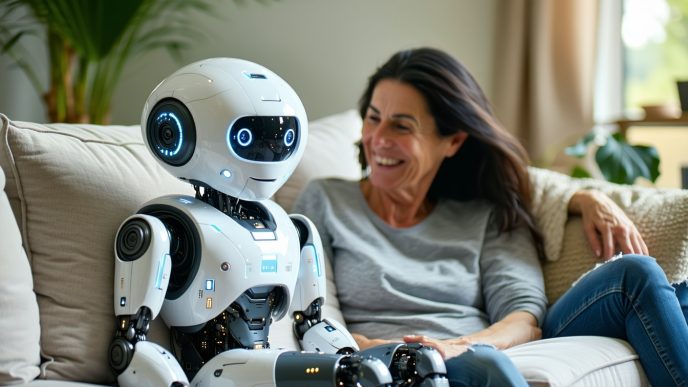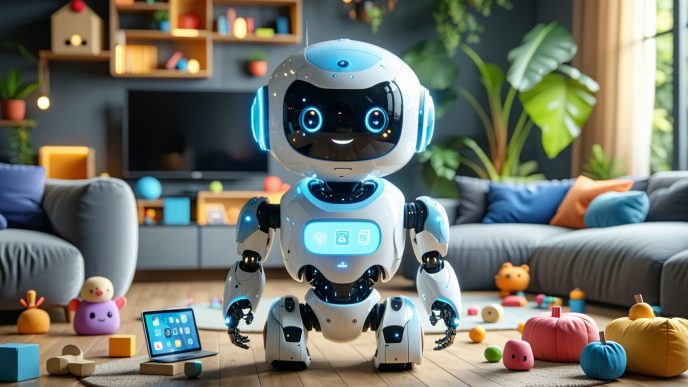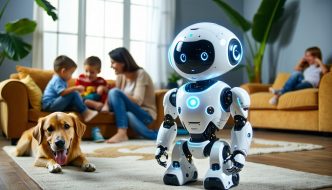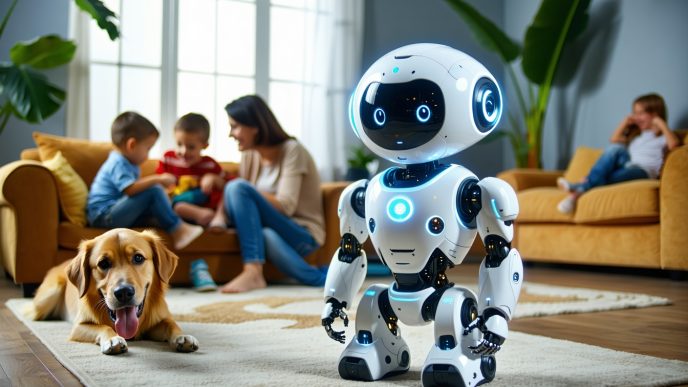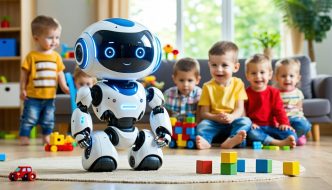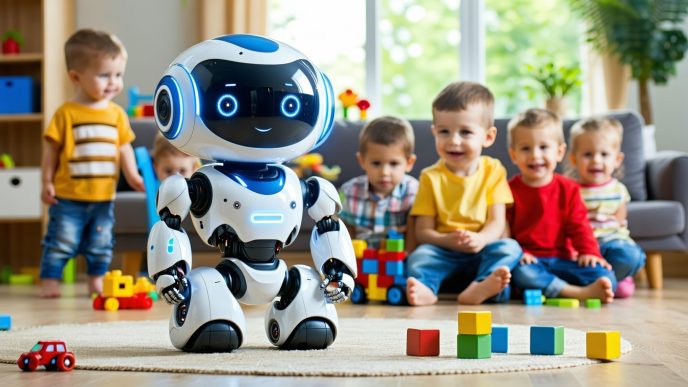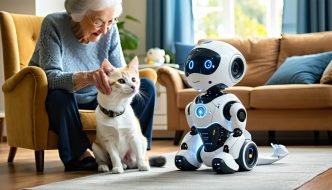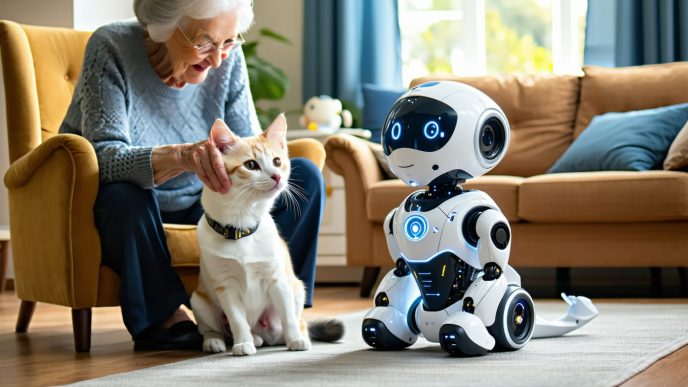The Rise of Companion Robots in Assisted Living
Understanding the Role of Companion Robots
Companion robots are increasingly being utilized in assisted living and elder care settings to provide emotional companionship, mental health support, and assistance with daily tasks. These robots are designed to engage with individuals in a natural and comforting manner, serving as a source of interaction for seniors who may experience loneliness or social isolation.
The primary function of companion robots is to facilitate emotional connections with residents. They can be programmed to recognize voices, respond to commands, and even mimic social behaviors, which can help create a sense of companionship. The introduction of companion robots in nursing homes addresses the growing need for personalized care solutions that improve the overall quality of life for residents. The benefits of implementing companion robots in these environments are substantial.
| Feature | Description |
|---|---|
| Emotional Engagement | Companion robots provide interaction and conversation, reducing feelings of loneliness. |
| Programming Capabilities | These robots can be customized to meet the specific needs of each resident, enhancing the user experience. |
| 24/7 Availability | Unlike human staff, companion robots are available for interaction at all times. |
Advantages of Utilizing Companion Robots in Elder Care
The deployment of companion robots in elder care facilities offers numerous advantages. By integrating technology into daily living, these robots can enhance the well-being of residents in several impactful ways.
-
Emotional Support: Companion robots can engage residents in conversation and activities, reducing feelings of loneliness and depression. This emotional support is vital for seniors, particularly those who might have limited social interactions. Research indicates that regular interaction with companion robots can lead to improved mood and emotional health.
-
Cognitive Stimulation: These robots can be programmed to play games, quizzes, and provide educational content, thus stimulating cognitive functions. Keeping the mind active is essential for maintaining cognitive health, particularly for seniors facing memory-related challenges such as dementia. Companion robots for dementia patients can play a specific role in enhancing cognitive engagement.
-
Assistance with Daily Tasks: Companion robots can help seniors with essential tasks, such as reminding them to take medications, providing health monitoring, and guiding them through physical exercises. The integration of technology into routine care contributes to a more comprehensive approach to health and wellness.
| Advantage | Impact on Residents |
|---|---|
| Emotional Support | Reduces loneliness and improves mood. |
| Cognitive Stimulation | Enhances brain function and prevents cognitive decline. |
| Daily Assistance | Facilitates independence and enhances quality of life. |
By embracing technology through the use of companion robots in assisted living, facilities can create a more supportive and engaging environment for elderly residents. This fosters improved mental and emotional well-being while addressing the practical challenges of elder care. For more information on the benefits of this technology, see our articles on robot pets for seniors and robot companions for mental health.
Types of Companion Robots
Companion robots are becoming increasingly popular in assisted living environments. They come in various forms, each designed to address specific needs and enhance the quality of life for residents. This section outlines three main types of companion robots: social companion robots, mental health support robots, and care assistance robots.
Social Companion Robots
Social companion robots are designed to engage users in conversation and provide companionship. These robots often have friendly designs and can perform simple tasks, but their primary purpose is to alleviate feelings of loneliness among seniors. They can interact through speech, recognize faces, and even tell jokes or stories.
| Feature | Description |
|---|---|
| Interaction Style | Conversational, storytelling, and games |
| Design | Friendly, approachable, often animal-like |
| Benefits | Reduces loneliness, stimulates social interaction |
Social companion robots can also provide updates on current events or assist in recreational activities, making them valuable additions to nursing homes. For a more in-depth exploration of robotic pets designed for companionship, explore our article on robot pets for seniors.
Mental Health Support Robots
These robots focus specifically on enhancing the mental well-being of users. Equipped with artificial intelligence, mental health support robots can analyze conversations and provide customized responses, offering reassurance and support to users dealing with feelings of anxiety or depression. They can also engage in activities that promote mindfulness.
| Feature | Description |
|---|---|
| Interaction Style | Conversational, therapeutic activities |
| Design | Calming imagery, soothing voice prompts |
| Benefits | Helps manage anxiety, promotes mental wellness |
Mental health support robots are becoming essential tools in elder care, as they address many emotional and psychological needs. For more insights into how these robots can assist specific populations, refer to our article on robot companions for mental health.
Care Assistance Robots
Care assistance robots are designed to help with daily living activities and tasks that may be challenging for elderly residents. These robots can remind users to take medications, assist in mobility, or even help with meal preparation. Their goal is to promote independence while ensuring safety.
| Feature | Description |
|---|---|
| Interaction Style | Task-oriented, reminders, safety checks |
| Design | Functional, user-friendly interfaces |
| Benefits | Supports independence, ensures safety, aids routine |
Care assistance robots can significantly enhance the quality of life for seniors by providing practical help and encouraging self-reliance. To learn more about how these robots function and their potential impact, check our article on companion robots for dementia patients.
Different types of companion robots play distinct roles in assisted living environments. Understanding these classifications helps caregivers and families select the appropriate solutions that enhance emotional and physical support in elder care settings. For further reading on the design and personalities of these robots, visit our article on companion robot design and personality.
Benefits of Companion Robots in Nursing Homes
Companion robots are becoming an integral part of assisted living environments. Their role extends beyond mere mechanical assistance, offering various benefits that enhance the lives of residents in nursing homes. These benefits include emotional support, cognitive stimulation, and assistance with daily tasks.
Emotional Support and Companionship
One of the primary advantages of companion robots is their ability to provide emotional support and companionship. Many elderly individuals experience loneliness and isolation, which can negatively impact their mental wellbeing. Companion robots are designed to interact naturally with residents, offering a form of company that can alleviate these feelings.
Research indicates that individuals who interact with companion robots report a sense of emotional connection and improved mood. These robots engage in conversations, play games, and even respond to the emotional states of users, helping foster a compassionate relationship.
| Emotional Benefits | Description |
|---|---|
| Reduces Loneliness | Offers companionship to those lacking social interaction. |
| Provides Comfort | Engages in conversations that provide emotional reassurance. |
| Enhances Mood | Positive interactions can lead to improved emotional states. |
Cognitive Stimulation and Mental Wellness
Companion robots are also effective in providing cognitive stimulation, which is crucial for maintaining mental wellness as individuals age. These robots can engage users in various activities that promote mental exercise, such as trivia games, memory tasks, and problem-solving puzzles.
Studies show that regular interaction with these devices can help slow cognitive decline, particularly in individuals experiencing early stages of dementia. The robots adapt their interactions based on the needs and capabilities of the users, helping to keep their minds active and engaged.
| Cognitive Benefits | Description |
|---|---|
| Memory Games | Encourages mental engagement through various activities. |
| Problem Solving Tasks | Stimulates cognitive abilities and critical thinking. |
| Personalized Interactions | Adapts to the cognitive level of the resident. |
Assistance with Daily Tasks
In addition to emotional and cognitive support, companion robots can assist with daily tasks, enhancing the overall quality of care provided in nursing homes. These robots can perform functions such as reminding residents to take medications, scheduling appointments, or guiding them through daily routines.
By alleviating some of the daily responsibilities, companion robots allow staff to focus on more healthcare-specific duties, improving the efficiency of care delivery. This technological assistance not only streamlines operations but also empowers residents by encouraging independence in their daily lives.
| Task Assistance | Description |
|---|---|
| Medication Reminders | Alerts residents when it’s time to take medications. |
| Daily Routines | Guides users through structured daily activities. |
| Appointment Scheduling | Helps manage and arrange medical visits. |
The introduction of companion robots in assisted living facilities provides numerous benefits, creating a supportive and engaging environment for elderly residents. By addressing emotional needs, stimulating cognitive functions, and assisting with routine tasks, these robots significantly enhance the quality of life for individuals in nursing homes. For more on how these robots interact, check out our article on human robot bonding.
Challenges and Considerations
While companion robots in assisted living present numerous benefits, there are significant challenges and considerations that must be addressed to ensure their successful integration and effectiveness in elder care settings.
Ethical and Privacy Concerns
The implementation of companion robots raises ethical questions regarding privacy and consent. There is a need to ensure that the use of robots does not infringe upon the personal privacy of residents. Considerations include data collection, observation habits, and how the information gathered by these robots may be used or shared.
A study highlighted the following concerns:
| Concern | Description |
|---|---|
| Data Privacy | Protecting sensitive information collected by robots. |
| Consent | Ensuring residents understand and agree to the use of robots. |
| Autonomy | Balancing robot assistance with the independence of residents. |
Human Interaction vs. Robot Interaction
The use of companion robots may potentially alter the nature of human interaction within elder care facilities. While robots can provide emotional support, they cannot fully replicate the companionship that human caregivers offer. It is vital to find a balance between the technological benefits of robots and the essential human connection that is often necessary for mental and emotional health.
Research has shown that many residents benefit from human interaction:
| Interaction Type | Importance |
|---|---|
| Human Caregivers | Offer empathy, understanding, and connection. |
| Robots | Provide companionship and perform routine tasks. |
Finding this balance can enhance the overall care experience for residents.
Maintenance and Technical Issues
Companion robots require regular maintenance and updates to function effectively. Technical issues can pose challenges in day-to-day operations. Staff must be trained not only to interact with these robots but also to troubleshoot any problems that arise. Furthermore, reliance on technology could lead to complications if robots malfunction or if staff are unprepared to handle such situations.
The following table outlines some common technical issues:
| Issue | Description |
|---|---|
| Software Malfunctions | Bugs or errors in the robot’s programming. |
| Hardware Problems | Physical wear and tear that affects functionality. |
| Connectivity Issues | Loss of internet connection that may disrupt service. |
Addressing these challenges is crucial to maximizing the benefits of companion robots and ensuring they serve as effective aids in elder care environments. For more information on companion robots, explore our article on companion robots.
Implementation of Companion Robots
The successful integration of companion robots into elder care facilities requires careful planning and execution. It involves multiple dimensions, such as adjusting the physical environment, equipping staff, and evaluating the impact of these technologies on residents.
Integrating Robots into Elder Care Facilities
Integrating companion robots into assisted living facilities requires a systematic approach. This often starts with assessing the specific needs of the residents and identifying which types of robots will best serve those needs. Facilities must evaluate the layout and accessibility for robots to function effectively.
| Key Factors for Integration | Description |
|---|---|
| Needs Assessment | Evaluate the emotional and physical needs of residents to choose appropriate robots. |
| Infrastructure Readiness | Ensure that facilities have the necessary technological infrastructure (Wi-Fi, charging stations). |
| Safety Protocols | Establish protocols to ensure the safety of residents when interacting with robots. |
Once these elements are in place, pilot programs can be initiated to test the robots’ functionalities within a controlled environment.
Training Staff and Residents for Interaction
Training is crucial for both staff and residents to maximize the effectiveness of companion robots. Personnel must understand how to assist residents in interacting with robots and troubleshoot any issues that may arise.
Training programs should cover:
- Robot Functions: Instruction on how to operate and maintain the robots.
- Interaction Techniques: Best practices for engaging residents with the robots for optimal emotional connection.
- Feedback Mechanisms: Training on how to gather feedback from residents regarding their experiences with robots.
Workshops can be conducted regularly to update staff and keep them informed about new features and capabilities of the robots. Involving residents in this training also encourages acceptance and reduces apprehension towards the technology.
Monitoring and Evaluating Robot Performance
Regular monitoring and evaluation of robot performance helps ensure they are meeting the desired objectives. Facilities should establish benchmarks to assess the robots’ impact, focusing on metrics such as:
| Performance Metrics | Description |
|---|---|
| Resident Engagement | Levels of interaction between residents and robots, gauging enthusiasm and participation. |
| Emotional Well-being | Surveys and assessments to evaluate changes in the emotional health of residents. |
| Task Efficiency | Effectiveness in completing designated care tasks, such as reminders for medication or companionship. |
Continuous assessment allows for necessary adjustments and improvements. Data collected can also inform future investments in technology and refine the approach to elder care.
By thoughtfully implementing companion robots, elder care facilities can enhance the quality of life for residents, providing both emotional and practical support. For different types of robots currently in use, refer to our section on companion robots. Exploring the benefits of these innovative technologies can pave the way for future advancements in elder care.
Future Outlook
The future of companion robots in assisted living environments holds great promise as technology continues to advance. These innovations aim to enhance the quality of care provided to elderly residents, offering both emotional support and practical assistance.
Technological Advancements in Companion Robots
With the ongoing development of artificial intelligence and robotics, companion robots are becoming increasingly sophisticated. Future advancements are expected to include:
| Technology Advancement | Description |
|---|---|
| Enhanced AI Learning | Improved algorithms allowing robots to adapt to individual preferences and behaviors. |
| Advanced Natural Language Processing | More fluid conversation abilities, making interactions feel more natural. |
| Improved Sensor Technology | Enhanced ability to understand and respond to the physical environment and the needs of residents. |
| Increased Mobility Features | Robots being equipped with better navigation capabilities to assist residents more effectively. |
These advancements aim to create a more engaging and supportive experience for seniors.
Impact on the Quality of Care Provided
The integration of companion robots into nursing homes has the potential to significantly improve the quality of care rendered to residents. Key impacts include:
| Impact Area | Benefit |
|---|---|
| Emotional Well-Being | Companion robots can combat loneliness and provide emotional support, promoting mental health. |
| Increased Interaction | More opportunities for social engagement through consistent companionship. |
| Enhanced Daily Living | Assistance with routine activities, freeing up staff to focus on more complex care needs. |
These factors collectively contribute to a healthier, more fulfilling living environment for elderly individuals.
Potential for Enhanced Elder Care with Companion Robots
The future landscape of elder care may see companion robots widely adopted. Their potential benefits include:
- Emotional Support: They can reduce feelings of isolation, providing companionship to seniors who may otherwise feel alone.
- Cognitive Support: Robots designed for mental health can engage residents in stimulating activities, which may help delay cognitive decline. More information on this topic can be found in our article on robot companions for mental health.
- Tailored Care: As robots evolve, they are likely to offer personalized interactions that cater to the unique preferences of each resident, enhancing the overall quality of care.
Continued research into the dynamics of human robot bonding and understanding the design and personality of companion robots will further advance these technologies, ensuring they effectively meet the needs of seniors in assisted living settings.


